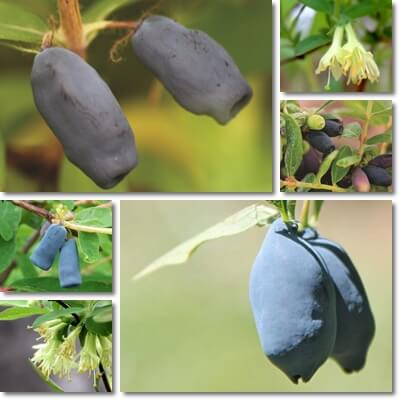Also called the honeyberry because of the sweet, honey-like taste of its berries, the blue honeysuckle is one of almost 200 known species of its kind. Its scientific name is Lonicera caerulea, but it is best known by its common names: blue honeysuckle, blue-berried honeysuckle, honeyberry, haskap, sweetberry honeysuckle, fly honeysuckle and more. The choice of common name is often regionally determined. The species occurs naturally in the temperate zone of the Northern Hemisphere, favoring cooler regions. Like most, if not all honeysuckles, Lonicera caerulea is considered an invasive species and can be found outside its native range. At present, there are about a dozen cultivated varieties of the species.
Unlike many other species, the blue honeysuckle has edible berries that are both a source of good nutrition and health benefits. The berries are rich in antioxidants such as proanthocyanidins and anthocyanins, flavonoids such as luteolin and organic acids such as citritc acid, with free radical-scavenging, anti-inflammatory and hepato-protective properties and anti-proliferative, antibacterial and antifungal activity. According to studies, the berries are richest in vitamin C, the antioxidant mineral manganese, potassium and dietary fiber, but overall modestly nutritious, in line with the nutrition of berries in general. The nutrition profile of blue honeysuckle berries, namely the micro and macro-nutrient content and antioxidant profile, is fairly similar to that of blueberries.

What does blue honeysuckle look like?
While most honeysuckles are climbing vines, the blue honeysuckle plant does not climb and looks more like a shrub or bush, with multiple woody stems arising from the ground or near the ground. The plant typically grows to about 2 meters in height and is wide and bushy in appearance, but different varieties of the species may grow to different sizes. The leaves have a typical appearance, oval-shaped, gray-green in color, with a smooth, soft surface. The flowers are also typical of honeysuckles, tubular or somewhat trumpet-shaped and pale yellow in color, growing in pairs. The flowers produce an edible, sweet nectar that is a favorite of bees, butterflies, moths and hummingbirds. The fruits of the species, which are dark blue in color when ripe, are also edible. Birds especially, but also other wildlife, including deer, frequently eat the ripe berries which are a staple in their diets in the native areas of the species. It’s good to remember that, while most honeysuckle plants have berries, not all are edible.
Are blue honeysuckle berries edible?
Fruits of the Lonicera caerulea species are edible and safe to eat both raw and cooked or otherwise processed. Common uses include: jams, jellies, sauces, chutneys, syrups, dessert toppings, fruit juices, smoothies, fermented beverages. Blue honeysuckle berry pie tastes just as good as blueberry pie. You can eat blue honeysuckle berries fresh, frozen, dried and cooked, by themselves or incorporated into other food items such as yogurts, ice cream, breakfast cereal mixes, dried fruits mixes, pastry fillings and other baked goods.
What do blue honeysuckle berries look like?
The ripe fruits of the Lonicera caerulea species, or the blue honeysuckle, are elongated, either oval-shaped or rectangular-looking, with almost-right angles. They have a tiny depression at the end opposite to the stem, similar to bilberries. The fruits are quite small, weighing a little over 2 grams each and have multiple seeds. Blue honeysuckle berries typically ripen in May, but depending on climate and weather conditions, they may be ready for harvest anywhere from mid/late spring to early summer (all throughout July). The ripe berries have dark blue skin and purple-red flesh. The underripe berries have dark blue skin and greenish flesh and are not as palatable.
What do blue honeysuckle berries taste like?
Not only are blue honeysuckle berries edible, but they’re also quite tasty. Overall, the ripe berries have a pleasantly sweet, honey-like taste, reminiscent of raspberries, blueberries or amelanchier, but with tangy notes from the organic acids they contain. The riper the fruits, the sweeter they are (hence the common names honeyberry and sweetberry honeysuckle). The underripe fruits have dark blue skin and greenish flesh and are both sour and sweet. The seeds are not very noticeable when eating. The deep blue-purple colors of the ripe fruits are attributed to pigmented anthocyanin antioxidants and can stain skin, lips and clothes. Also see benefits of amelanchier berries.

Blue honeysuckle berries nutrition
The fruits of the Lonicera caerulea species have a nutrition profile and antioxidant status similar to that of blueberries or bilberries. Studies show they are rich in antioxidants, but boast an overall modest nutrition, in line with the nutritional status of other edible wild berry species. Overall, ripe blue honeysuckle berries are richest in vitamin C (between 3.2 and 32.1 and up to 44 mg of vitamin C/100 g fresh fruits), the antioxidant mineral manganese and provide modest amounts of potassium, but no sodium. Other essential micro-nutrients found in small to trace amounts are B complex vitamins (B1, B2, B3, B5, B6, B9), vitamin E, calcium, copper, iron, magnesium, phosphorus and zinc. Lastly, the fruits are a good source of dietary fiber, estimated at around 2 g of fiber/100 g of fruit, low in calories, fat and protein, and a significant source of carbohydrates.
- Blue honeysuckle berries Nutrition facts per 100 g
- Water content: 85.5 g
- Energetic value: 53 kcal per
- Protein: 0.7 g
- Fat: 0.6 g
- Cholesterol: 0 g
- Carbohydrate: 12.8 g
- Sugar:
- Dietary fiber: 2.1 g of which 0.6 g soluble fiber, 1.5 insoluble fiber
- Calcium: 38 mg
- Copper: 0.06 mg
- Iron: 0.6 mg
- Magnesium: 11 mg
- Phosphorus: 25 mg
- Potassium: 190 mg
- Zinc: 0.1 mg
- Vitamin A (in beta-carotene equivalents): 130 mcg (11 mg retinol activity equivalent, RAE)
- Vitamin D: 0 mcg
- Vitamin E: 1.1 mg alpha-Tocopherol, 0.3 mg gamma-Tocopherol
- Vitamin K: 0 mcg
- Vitamin B1: 0.02 mg
- Vitamin B2: 0.03 mg
- Vitamin B3: 0.5 mg
- Vitamin B5: 0.29 mg
- Vitamin B6: 0.04 mg
- Vitamin B9: 7 mcg
- Vitamin B12: 0 mcg
- Vitamin C: 44 mg
Nutritional information from the Standard Tables of Food Composition in Japan, via fao.org. However, the exact content of essential vitamins and minerals may differ between fruits according to cultivated variety, age of the fruits at harvest time, soil quality (availability of micro-nutrients in the soil), cooking and processing undergone and other factors. As a result, different sources will report different nutrient contents.
Antioxidants in the fruit species include:
- Anthocyanins, the best represented antioxidants in the fruit, responsible for the dark blue colors: cyanidin-3-glucoside (accounts for 84-92% of total anthocyanin content, according to a study), cyanidin 3-rutinoside, cyanidin 3,5-diglucoside, peonidin 3-glucoside, pelargonidin 3-glucoside, peonidin 3-rutinoside.
- Polyphenols: chlorogenic acid, neochlorogenic acid, quercetin 3-rutinoside, and quercetin 3-glucoside, 6 flavan-3-ols, flavanols, flavones (luteolin), flavanonols, proanthocyanidins, organic acids (citric acid), and vitamin C.
What are the benefits?
Considering their modest nutrition, the benefits of eating blue honeysuckle berries are, for the most part, a result of an impressive antioxidant content and may include:
- Benefits for weight loss thanks to a low energetic value (only 53 kcal/100 g), low fat content and good dietary fiber content (2.1 g of fiber/100 g).
- Minor benefits for digestion, including constipation relief, thanks to a good fiber content and high water content.
- Antioxidant activity comparable to that of wild European blueberries, promoting reduction of oxidative stress markers and associated cell damage, with potential anti-proliferative benefits.
- Strong anti-inflammatory action as a result of a rich antioxidant content, resulting in the inhibition of several major pro-inflammatory cytokines including IL-6, TNF-α and PGE2 (source).
- Antimicrobial and antifungal activity of the freeze-dried fruit against Staphylococcus epidermidis, Escherichia coli, Enterococcus faecalis, and Streptococcus mutans, Candida parapsilosis (study).
- Hepato-protective effects exhibited by various antioxidants in the fruit.
- Minor cardiovascular benefits for high blood pressure as a result of the modest content of potassium and magnesium in the fruits, as well as lack of sodium.
- Minor vascular benefits from antioxidants and vitamin C which promotes synthesis of collagen and contributes to blood vessel elasticity and improved endothelial function.
